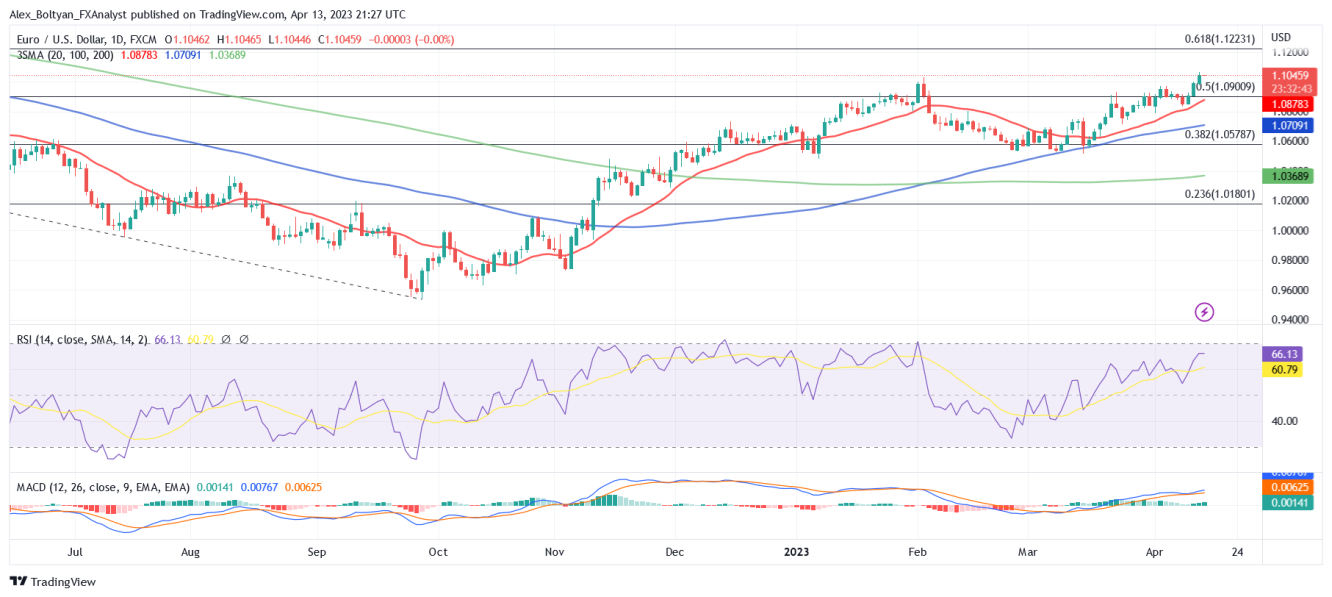The EUR/USD has managed to maintain its upward momentum, holding above the critical psychological level of 1.1000. The euro rose for a third straight day on Thursday amid reports suggesting that the European Central Bank (ECB) policymakers are in agreement regarding a potential 25 basis point rate hike in May. Meanwhile, the U.S. dollar continued to weaken following lower-than-expected wholesale inflation numbers.
At the time of writing, the EUR/USD pair is trading at 1.1045, 0.5% above its opening price, after hitting its highest level in a year at 1.1067.
On Thursday, the U.S. reported Producer Price Index (PPI) and jobless claims data. The annual wholesale inflation, measured by the PPI, came in at 2.7% in March, below expectations of 3%, while the core rate was 3.4% in the same period, in line with consensus. In addition, initial jobless claims data for the week that ended April 8 rose to 239,000 versus the 232,000 expected.
The greenback fell across the board as softer inflation and job numbers have fueled expectations the Federal Reserve will hike one more time and then take a pause. According to the WIRP tool, investors are betting on probabilities of 67% of a 25 bps hike in May that would take the Fed funds range to 5.00%-5.25%. In addition, markets are now discounting higher probabilities of the FOMC cutting rates by the year-end.
From a technical perspective, the EUR/USD maintains a short-term bullish outlook as per indicators on the daily chart. The RSI and MACD are both in positive territory, not yet tagging overbought levels, while the price remains above its main moving averages, suggesting the buyers have the upper hand.
On the upside, a break above 1.1070 would pave the way for more gains, targeting the 1.1100 area and the critical 200-week SMA at 1.1199. A break above this level would improve the longer-term perspective. On the downside, the 1.1000 level stands as the immediate support level, followed by the 1.0950 and 1.0900 areas.
- English (UK)
- English (India)
- English (Canada)
- English (Australia)
- English (South Africa)
- English (Philippines)
- English (Nigeria)
- Deutsch
- Español (España)
- Español (México)
- Français
- Italiano
- Nederlands
- Português (Portugal)
- Polski
- Português (Brasil)
- Русский
- Türkçe
- العربية
- Ελληνικά
- Svenska
- Suomi
- עברית
- 日本語
- 한국어
- 简体中文
- 繁體中文
- Bahasa Indonesia
- Bahasa Melayu
- ไทย
- Tiếng Việt
- हिंदी
EUR/USD Hits Highest Level in a Year After U.S. Data
Published 04/13/2023, 05:29 PM
Updated 07/09/2023, 06:32 AM
EUR/USD Hits Highest Level in a Year After U.S. Data
Latest comments
Loading next article…
Install Our App
Risk Disclosure: Trading in financial instruments and/or cryptocurrencies involves high risks including the risk of losing some, or all, of your investment amount, and may not be suitable for all investors. Prices of cryptocurrencies are extremely volatile and may be affected by external factors such as financial, regulatory or political events. Trading on margin increases the financial risks.
Before deciding to trade in financial instrument or cryptocurrencies you should be fully informed of the risks and costs associated with trading the financial markets, carefully consider your investment objectives, level of experience, and risk appetite, and seek professional advice where needed.
Fusion Media would like to remind you that the data contained in this website is not necessarily real-time nor accurate. The data and prices on the website are not necessarily provided by any market or exchange, but may be provided by market makers, and so prices may not be accurate and may differ from the actual price at any given market, meaning prices are indicative and not appropriate for trading purposes. Fusion Media and any provider of the data contained in this website will not accept liability for any loss or damage as a result of your trading, or your reliance on the information contained within this website.
It is prohibited to use, store, reproduce, display, modify, transmit or distribute the data contained in this website without the explicit prior written permission of Fusion Media and/or the data provider. All intellectual property rights are reserved by the providers and/or the exchange providing the data contained in this website.
Fusion Media may be compensated by the advertisers that appear on the website, based on your interaction with the advertisements or advertisers.
Before deciding to trade in financial instrument or cryptocurrencies you should be fully informed of the risks and costs associated with trading the financial markets, carefully consider your investment objectives, level of experience, and risk appetite, and seek professional advice where needed.
Fusion Media would like to remind you that the data contained in this website is not necessarily real-time nor accurate. The data and prices on the website are not necessarily provided by any market or exchange, but may be provided by market makers, and so prices may not be accurate and may differ from the actual price at any given market, meaning prices are indicative and not appropriate for trading purposes. Fusion Media and any provider of the data contained in this website will not accept liability for any loss or damage as a result of your trading, or your reliance on the information contained within this website.
It is prohibited to use, store, reproduce, display, modify, transmit or distribute the data contained in this website without the explicit prior written permission of Fusion Media and/or the data provider. All intellectual property rights are reserved by the providers and/or the exchange providing the data contained in this website.
Fusion Media may be compensated by the advertisers that appear on the website, based on your interaction with the advertisements or advertisers.
© 2007-2025 - Fusion Media Limited. All Rights Reserved.
